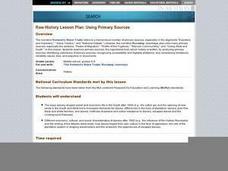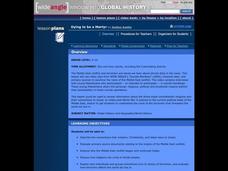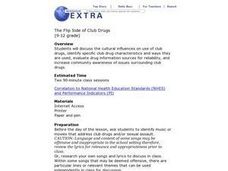Curated OER
Science Current Events
Seventh graders write science current events articles using various media sources.
Curated OER
Twain's Hannibal
Young scholars use primary resources to examine the context the writings of Mark Twain. They criticize the resources for reliability, accuracy, perspective, relevancy, and authoritativeness.
Curated OER
Researching Skills: Researching on the Web
How do researchers narrow their searches so that they get the most useful and accurate information available? This essential question is at the heart of the activities suggested by a research skills learning exercise. Tips include how to...
Curated OER
The Formation of Fossil Fuels
Students participate in an activity in which they explain the difference between renewable and nonrenewable sources of energy. They discover why the supply of fossil fuels is limited and practice using new vocabulary.
Curated OER
Teaching With Documents Lesson Plan: Images of the American Revolution
Students interpret historical evidence presented in primary and secondary resources. In this American Revolution lesson, students examine international involvement in the war as well as major events of the war.
Curated OER
Death and Taxes
Students explore the "death tax" and analyze statistical information about how the government taxes dead people. They research sources to determine the validity of a anti-tax group campaign and John McCain's claims about taxes. ...
Curated OER
RAW HISTORY: USING PRIMARY SOURCES
Students analyze the ways slavery shaped social and economic life in the South after 1800, how slaves forged their own culture in the face of oppression; and the role of the plantation system in shaping slaveholders and the enslaved.
American Press Institute
Media Literacy: Where News Comes From
What actually happens at a press conference? Make sense of the mayhem with a mock press conference activity designed to promote media literacy. Individuals participate as either members of the press or the governor's office to examine...
Stanford University
Explosion of the Maine
An intriguing lesson features newspaper articles to help academics understand the political impact of the sinking the Maine and how the American media depicted the event. Scholars also view a presentation, participate in group...
Newseum
Evidence: Do the Facts Hold Up?
Sometimes it's hard to escape bad information! Pupils learn the E.S.C.A.P.E. method for evaluating news sources and complete a worksheet to assess a news article using their new skills.
Newseum
E.S.C.A.P.E. Junk News
Fair, balanced, and reputable information? There's an acronym for that! Scholars learn the E.S.C.A.P.E. method for evaluating news sources. Then, pupils work in small groups to read and analyze a news story and discuss the activity to...
English Enhanced Scope and Sequence
Research Project Embedded with Media Literacy
Here is a phenomenal language arts instructional activity on media literacy for your middle and high schoolers. In it, learners produce a research product in the form of a public service announcement (PSA). First, they view examples of...
American Chemical Society
Curious Crystals
Crystals are more than meets the eye! Can learners tell them apart simply by observation? As they examine five samples with a magnifier, they find that appearance alone is not enough. This serves as an introduction to a mini unit on...
Curated OER
Fact or Fiction? Urban Legends and Misconceptions
Students are introduced to a process for using web site resources to verify the accuracy of biology information. They follow a guided instructional activity on evaluating web sites and determining content accuracy. They select a piece of...
Curated OER
Batteries and Emerging Technology
For this batteries worksheet, students read about how batteries work and the types of batteries. They answer three critical thinking questions about batteries and their use as alternate-fuel sources.
Curated OER
Identifying Bias
In this identifying bias worksheet, students read about bias and how to identify it in their reading. They are given a list of sources of bias and they read 2 paragraphs and determine the kind of bias and their reasoning for choosing the...
Curated OER
Dying to be a Martyr
Young scholars study primary source document that describe the beginnings of the Middle East conflict. They survey the connections that Judaism, Christianity, and Islam have to Israel.
Curated OER
The Flip Side of Club Drugs
Students discuss the influences of club drugs on America's culture. They identify the characteristics of these drugs and how they are used. They examine drug sources and discuss how to increase community awareness.
Stanford University
Chicago Race Riots of 1919
Students explore the Chicago Race Riots of 1919. In this American history lesson, students watch the move "Up South" regarding the African American migration following World War I. Students read primary documents regarding the race riots...
Brown University
The Candidates and Their Values: Election 2016
Voting for the next president of the United States is about finding the candidate who most closely aligns with your own values and sense of democracy. High schoolers become acquainted with the candidates from the 2016 election with a...
ProCon
Drug Use in Sports
The ancient Greeks used performance enhancing drugs, such as opium juice, when they participated in the original Olympic Games. Pupils research a website with debate topics to decide if athletes' use of such drugs in modern sports is...
Curated OER
bbc news: school report
In this language arts/social studies worksheet, learners rank on a scale of 1 to 10 , twelve different news sources. Students rank them according to reliability, and then provide an example of each kind of news source. There is one...
Curated OER
Teaching a Short Story
Students work in small groups and prepare an analysis of a short story to be presented to their peers. They research the story and create a handout or a visual aid that cites sources of information and summarizes the main points of the...
Curated OER
Famous Virginians
Fourth graders research a famous Virginian. They cite sources of the facts and data which they gather from a variety of sources. They present the material using PowerPoint and an oral presentation.

























